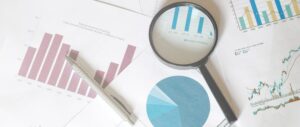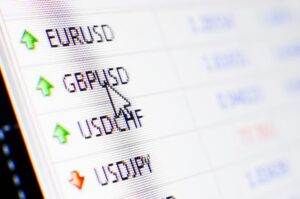
Master the art of forex trading with our essential guide. Learn the basics, set up your account, and develop effective strategies. Start trading today!
Please be advised that our Client Portal is scheduled for essential maintenance this weekend from market close on Friday 5th April, 2024, and should be back up and running before markets open on Sunday 7th April, 2024.
CFDs are complex instruments and come with a high risk of losing money rapidly due to leverage. 61% of retail investor accounts lose money when trading CFDs with this provider.
You should consider whether you understand how CFDs work and whether you can afford to take the high risk of losing your money.

130
$10
0.1
500:1
This article should have given you a better starting point for making your first forex trade or, at the very least, indicated why trading forex is just not for you.
Understanding the three main types of forex market analysis – technical, fundamental, and sentiment – can help you construct a stronger trading strategy.
Discover effective Forex trading strategies. Learn how to navigate the dynamic world of foreign exchange markets with proven techniques and insights.
The article provides tips for forex trading beginners, including common mistakes new traders make. In summary, take your time to learn properly and practice.
The Forex market’s international and decentralised nature allows it to be open 24 hours a day, five days a week.
| Initial Minimum Funding | $10 |
| Commissions | none |
| Spread Type | Floating |
| Minimum Order Size | 0.01 lot = 1,000 of base currency |
| Stopout Level | Equity = 40% of used margin |
| Server Time | GMT+3 |
| Account Denomination | USD, EUR, GBP |
24 hours a day as follows:
Bullion is now Sunday 23:05 (London time) to Friday 21:55 (London time) with a daily break between 22:00 (London time) and 23:00 (London time)
FX is Sunday 22:05 (London time) to Friday 21:55 (London time) with a daily break between 21:58 (London time) and (22:03 London time)
Please take note that trading hours may change during holidays. Clients will be informed of any changes by email.
Major currency pairs (underlying currency pair is composed of any 2 of the following currencies: USD, EUR, JPY, GBP, CAD or CHF).
| Minimum funding | $100 |
| Margin Requirements | 3.33% |
| Commissions | None |
| Spread Type | Floating |
| Execution | Market Execution |
| Minimum Order Size | 0.01 lot = 1,000 of base currency |
| Stopout Level | 50% |
| Server Time | GMT+3 |
| Account denomination | USD, EUR, GBP, CHF, CAD, AUD, AED |
24 hours a day as follows:
Bullion is now Sunday 23:05 (London time) to Friday 21:55 (London time) with a daily break between 22:00 (London time) and 23:00 (London time)
FX is Sunday 22:05 (London time) to Friday 21:55 (London time) with a daily break between 21:58 (London time) and (22:03 London time)
Please take note that trading hours may change during holidays. Clients will be informed of any changes by email.
Our market leading Learning Hub is a free resource to help you become an accomplished and successful trader.
Currency trading has soared in popularity this century amongst professional and non-professional traders alike. Before the arrival of the Contract for Difference (CFD) market in the late 1990s, currency trading was an asset class that was difficult for individuals to trade or invest in. Read more about currency trading here.
If you had a negative view for the Euro, perhaps because you felt that the Eurozone economy was performing poorly and was going to continue as such, you might look to short the Euro.
You might also have a view that the UK economy was looking healthy and that the short-term data was going to reflect this and beat expectations.
In this case, you would look to express your view by selling the Euro and buying the GB Pound, which would be a short position on the EURGBP currency pair.
Let’s say you sold EURGBP at 0.8500, with a target for a move down to 0.8000. You might then place a stop loss at 0.8700 in case the currency pair moved in the opposite direction.
Bid
The rate at which you can sell the base currency, in our case it’s the Euro, and buy the quote currency, i.e. the Japanese Yen.
Ask (or Offer)
The rate at which you can buy the base currency, in our case, the British Pound, and sell the quoted currency, i.e. the Japanese Yen.
Spreads
The difference between the Bid and the Ask prices.
Currency rate
The value of one currency expressed in terms of another. Its fluctuation depends on numerous factors including the supply and demand on the market and/or open market operations by a government or by a central bank.
Lot
Usually, the contract size is based on a lot system, and for most currency pairs 1 lot is 100,000 units of a base currency.
Pip
Minimum rate fluctuation
Account types
Hantec Markets offers a variety of live and demo trading accounts, including Joint and Corporate accounts.
Currency trading has soared in popularity this century amongst professional and non-professional traders alike. Before the arrival of the Contract for Difference (CFD) market in the late 1990s, currency trading was an asset class that was difficult for individuals to trade or invest in. Read more about forex trading here.
If you had a negative view for the Euro, perhaps because you felt that the Eurozone economy was performing poorly and was going to continue as such, you might look to short the Euro.
You might also have a view that the UK economy was looking healthy and that the short-term data was going to reflect this and beat expectations.
In this case, you would look to express your view by selling the Euro and buying the GB Pound, which would be a short position on the EURGBP currency pair.
Let’s say you sold EURGBP at 0.8500, with a target for a move down to 0.8000. You might then place a stop loss at 0.8700 in case the currency pair moved in the opposite direction.
1. Breakout
This long-term strategy uses breaks as trading signals. Markets sometimes swing between support and resistance bands. Read more about breakout trading.
2. Moving average cross
Another Forex strategy uses the simple moving average (SMA). Moving averages are a lagging indicator that uses more historical price data than most strategies and moves more slowly than the current market price.
Other strategies include:
Bollinger band strategy
Momentum indicator forex strategy
Fibonacci strategy
MACD forex strategy
RSI indicator forex strategy
Risks every beginner should be aware of.
There are different types of risks that you should be aware of as a Forex trader. Keep the following risks in your Forex trading notes for beginners:Bid
The rate at which you can sell the base currency, in our case it’s the Euro, and buy the quote currency, i.e. the Japanese Yen.
Ask (or Offer)
The rate at which you can buy the base currency, in our case, the British Pound, and sell the quoted currency, i.e. the Japanese Yen.
Spreads
The difference between the Bid and the Ask prices.
Currency rate
The value of one currency expressed in terms of another. Its fluctuation depends on numerous factors including the supply and demand on the market and/or open market operations by a government or by a central bank.
Lot
Usually, the contract size is based on a lot system, and for most currency pairs 1 lot is 100,000 units of a base currency.
Pip
Minimum rate fluctuation
Account types
Hantec Markets offers a variety of live and demo trading accounts, including Joint and Corporate accounts.
Access the Hantec Markets MetaTrader4 platform, an award-winning technology available on desktop, mobile and Mac.

Master the art of forex trading with our essential guide. Learn the basics, set up your account, and develop effective strategies. Start trading today!

In this post, we dip into the 3 main types of forex market analysis – technical, fundamental, sentiment. Which type you will use in trading is up to you!

Here’s a look at the top 4 currency pairs that were most commonly traded in 2023: XAUUSD, EURUSD, USDJPY and GBPUSD.
Risk Warning
CFDs are complex instruments and come with a high risk of losing money rapidly due to leverage. 61% of retail investor accounts lose money when trading CFDs with this provider. You should consider whether you understand how CFDs work and whether you can afford to take the high risk of losing your money.
Please click here to view our Risk Disclosure.
Hantec Markets use cookies to enhance your experience on our website. By staying on our website you agree to our use of cookies.
You can access our Cookie Policy here
Risk Warning
CFDs are complex instruments and come with a high risk of losing money rapidly due to leverage.
You should consider whether you understand how CFDs work and whether you can afford to take the high risk of losing your money.
Please click here to view our Risk Disclosure.
Hantec Markets use cookies to enhance your experience on our website. By staying on our website you agree to our use of cookies. You can access our Cookie Policy here
Hantec Markets is a trading name of Hantec Group.
This website is owned and operated by Hantec Markets Holdings Limited. Hantec Markets Holdings Limited is the holding company of Hantec Markets Limited and Hantec Markets Ltd.
Hantec Markets Limited is authorised and regulated by the Financial Conduct Authority (FCA) in the UK (Register no: FRN 502635).
Hantec Markets Ltd. is authorised and regulated as an Investment Dealer by The Financial Services Commission of Mauritius (License no: C114013940).
The services of Hantec Markets and information on this website are not aimed at residents of certain jurisdictions, and are not intended for distribution to, or use by, any person or entity in any jurisdiction or country where such distribution or use may be contrary to any of the laws or regulations of that jurisdiction. The products and services described herein may not be available in all countries and jurisdictions. Those who access this site do so on their own initiative, and are therefore responsible for compliance with applicable local laws and regulations. The release does not constitute any invitation or recruitment of business.
Hantec Markets does not offer its services to residents of certain jurisdictions including the USA, Iran, Myanmar, North Korea and the United Arab Emirates.

Lorem ipsum dolor sit amet, consectetur adipiscing elit. Ut elit tellus, luctus nec ullamcorper mattis, pulvinar dapibus leo.
Lorem ipsum dolor sit amet, consectetur adipiscing elit. Ut elit tellus, luctus nec ullamcorper mattis, pulvinar dapibus leo.
Lorem ipsum dolor sit amet, consectetur adipiscing elit. Ut elit tellus, luctus nec ullamcorper mattis, pulvinar dapibus leo.


We are transferring you to our affiliated company Hantec Trader.
Please note: Hantec Trader does not accept customers from the USA or other restricted countries.